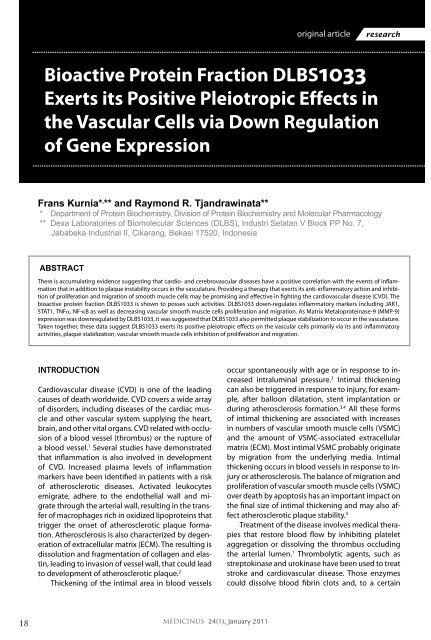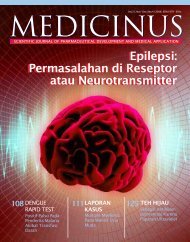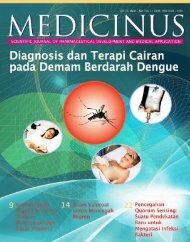Medicinus - Dexa Medica
Medicinus - Dexa Medica
Medicinus - Dexa Medica
Create successful ePaper yourself
Turn your PDF publications into a flip-book with our unique Google optimized e-Paper software.
18<br />
Bioactive Protein Fraction DLBS1033<br />
Exerts its Positive Pleiotropic Effects in<br />
the Vascular Cells via Down Regulation<br />
of Gene Expression<br />
Frans Kurnia* , ** and Raymond R. Tjandrawinata**<br />
* Department of Protein Biochemistry, Division of Protein Biochemistry and Molecular Pharmacology<br />
** <strong>Dexa</strong> Laboratories of Biomolecular Sciences (DLBS), Industri Selatan V Block PP No. 7,<br />
Jababeka Industrial II, Cikarang, Bekasi 17520, Indonesia<br />
ABSTRACT<br />
There is accumulating evidence suggesting that cardio- and cerebrovascular diseases have a positive correlation with the events of inflammation<br />
that in addition to plaque instability occurs in the vasculature. Providing a therapy that exerts its anti-inflammatory action and inhibition<br />
of proliferation and migration of smooth muscle cells may be promising and effective in fighting the cardiovascular disease (CVD). The<br />
bioactive protein fraction DLBS1033 is shown to posses such activities. DLBS1033 down-regulates inflammatory markers including JAK1,<br />
STAT1, TNFα, NF-kB as well as decreasing vascular smooth muscle cells proliferation and migration. As Matrix Metaloproteinase-9 (MMP-9)<br />
expression was downregulated by DLBS1033, it was suggested that DLBS1033 also permitted plaque stabilization to occur in the vasculature.<br />
Taken together, these data suggest DLBS1033 exerts its positive pleiotropic effects on the vascular cells primarily via its anti inflammatory<br />
activities, plaque stabilization, vascular smooth muscle cells inhibition of proliferation and migration.<br />
INTRODUCTION<br />
Cardiovascular disease (CVD) is one of the leading<br />
causes of death worldwide. CVD covers a wide array<br />
of disorders, including diseases of the cardiac muscle<br />
and other vascular system supplying the heart,<br />
brain, and other vital organs. CVD related with occlusion<br />
of a blood vessel (thrombus) or the rupture of<br />
a blood vessel. 1 Several studies have demonstrated<br />
that inflammation is also involved in development<br />
of CVD. Increased plasma levels of inflammation<br />
markers have been identified in patients with a risk<br />
of atherosclerotic diseases. Activated leukocytes<br />
emigrate, adhere to the endothelial wall and migrate<br />
through the arterial wall, resulting in the transfer<br />
of macrophages rich in oxidized lipoproteins that<br />
trigger the onset of atherosclerotic plaque formation.<br />
Atherosclerosis is also characterized by degeneration<br />
of extracellular matrix (ECM). The resulting is<br />
dissolution and fragmentation of collagen and elastin,<br />
leading to invasion of vessel wall, that could lead<br />
to development of atherosclerotic plaque. 2<br />
Thickening of the intimal area in blood vessels<br />
MEDICINUS 24(1), January 2011<br />
original article<br />
research<br />
occur spontaneously with age or in response to increased<br />
intraluminal pressure. 3 Intimal thickening<br />
can also be triggered in response to injury, for example,<br />
after balloon dilatation, stent implantation or<br />
during atherosclerosis formation. 3,4 All these forms<br />
of intimal thickening are associated with increases<br />
in numbers of vascular smooth muscle cells (VSMC)<br />
and the amount of VSMC-associated extracellular<br />
matrix (ECM). Most intimal VSMC probably originate<br />
by migration from the underlying media. Intimal<br />
thickening occurs in blood vessels in response to injury<br />
or atherosclerosis. The balance of migration and<br />
proliferation of vascular smooth muscle cells (VSMC)<br />
over death by apoptosis has an important impact on<br />
the final size of intimal thickening and may also affect<br />
atherosclerotic plaque stability. 5<br />
Treatment of the disease involves medical therapies<br />
that restore blood flow by inhibiting platelet<br />
aggregation or dissolving the thrombus occluding<br />
the arterial lumen. 1 Thrombolytic agents, such as<br />
streptokinase and urokinase have been used to treat<br />
stroke and cardiovascular disease. Those enzymes<br />
could dissolve blood fibrin clots and, to a certain




